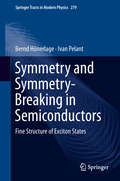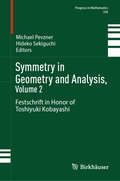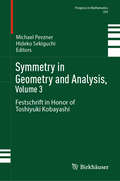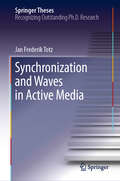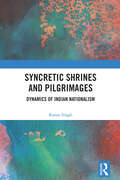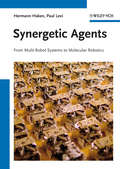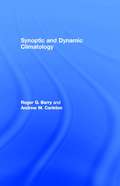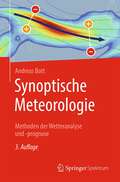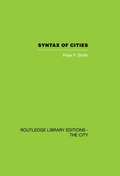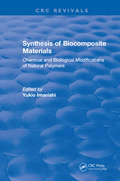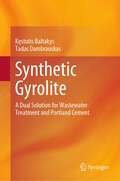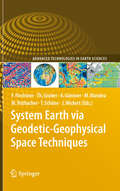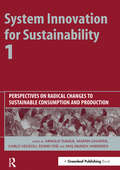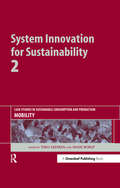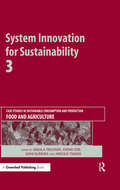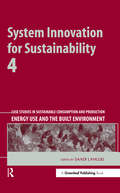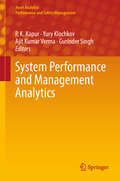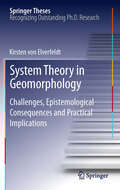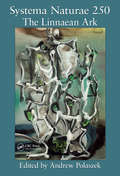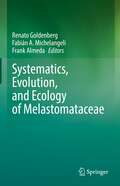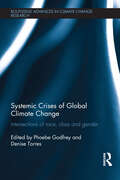- Table View
- List View
Symmetry and Symmetry-Breaking in Semiconductors: Fine Structure of Exciton States (Springer Tracts in Modern Physics #279)
by Bernd Hönerlage Ivan PelantThis book discusses group theory investigations of zincblende and wurtzite semiconductors under symmetry-breaking conditions. The text presents the group theory elements required to develop a multitude of symmetry-breaking problems, giving scientists a fast track to bypass the need for recalculating electronic states. The text is not only a valuable resource for speeding up calculations but also illustrates the construction of effective Hamiltonians for a chosen set of electronic states in crystalline semiconductors. Since Hamiltonians have to be invariant under the transformations of the point group, the crystal symmetry determines the multiplet structure of these states in the presence of spin-orbit, crystal-field, or exchange interactions. Symmetry-breaking leads to additional coupling of the states, resulting in shifts and/or splittings of the multiplets. Such interactions may be intrinsic, as in the case of the quasi-particle dispersion, or extrinsic, induced by magnetic, electric, or strain fields. Using a power expansion of the perturbations these interaction terms can be determined in their parameterized form in a unique way. The hierarchic structure of this invariant development allows to estimate the importance of particular symmetry-breaking effects in the Hamiltonian. A number of selected experimental curves are included to illustrate the symmetry-based discussions, which are especially important in optical spectroscopy. This text is written for graduate students and researchers who want to understand and simulate experimental findings reflecting the fine structure of electronic or excitonic states in crystalline semiconductors.
Symmetry in Geometry and Analysis, Volume 2: Festschrift in Honor of Toshiyuki Kobayashi (Progress in Mathematics #358)
by Michael Pevzner Hideko SekiguchiSymmetry in Geometry and Analysis is a Festschrift honoring Toshiyuki Kobayashi. The three volumes feature 35 selected contributions from invited speakers of twin conferences held in June 2022 in Reims, France, and in September 2022 in Tokyo, Japan. These contributions highlight the profound impact of Prof. Kobayashi’s pioneering ideas, groundbreaking discoveries, and significant achievements in the development of analytic representation theory, noncommutative harmonic analysis, and the geometry of discontinuous groups beyond the Riemannian context, among other areas, over the past four decades. This second volume of the Festschrift contains original articles on analytic methods in representation theory of reductive Lie groups and related topics. Contributions are by Salem Ben Saïd, Valentina Casarino, Paolo Ciatti, Jean-Louis Clerc, Jan Frahm, Joachim Hilgert, Toshihisa Kubo, Khalid Koufany, Quentin Labriet, Karl-Hermann Neeb, Yury Neretin, Gestur Ólafsson, Bent Ørsted, Toshio Oshima, Birgit Speh, Jorge Vargas, and Clemens Weiske.
Symmetry in Geometry and Analysis, Volume 3: Festschrift in Honor of Toshiyuki Kobayashi (Progress in Mathematics #359)
by Michael Pevzner Hideko SekiguchiSymmetry in Geometry and Analysis is a Festschrift honoring Toshiyuki Kobayashi. The three volumes feature 35 selected contributions from invited speakers of twin conferences held in June 2022 in Reims, France, and in September 2022 in Tokyo, Japan. These contributions highlight the profound impact of Prof. Kobayashi’s pioneering ideas, groundbreaking discoveries, and significant achievements in the development of analytic representation theory, noncommutative harmonic analysis, and the geometry of discontinuous groups beyond the Riemannian context, among other areas, over the past four decades. This third volume of the Festschrift contains original articles on branching problems in representation theory of reductive Lie groups and related topics. Contributions are by Ali Baklouti, Hidenori Fujiwara, Dmitry Gourevitch, Masatoshi Kitagawa, Salma Nasrin, Yoshiki Oshima, and Petr Somberg.
Symphony in C (Almost) Everything: Carbon And The Evolution Of (almost) Everything
by Robert M. HazenA Science News Favorite Book of 2019 An earth scientist reveals the dynamic biography of the most resonant—and most necessary—chemical element on Earth. Carbon. It’s in the fibers in your hair, the timbers in your walls, the food that you eat, and the air that you breathe. It’s worth billions of dollars as a luxury and half a trillion as a necessity, but there are still mysteries about the element that can be both diamond and coal. Where does it come from, what does it do, and why, above all, does life need it? With poetic storytelling, Robert M. Hazen leads us on a global journey through the origin and evolution of life’s most essential and ubiquitous element.
Synchronization and Triggering: from Fracture to Earthquake Processes
by Roman Teisseyre Valerio De Rubeis Zbigniew CzechowskiThis monograph contains experimental and theoretical considerations on synchronization and triggering in laboratory fracture experiments and in earthquake processes. Non-linear dynamics and the physics of rotational motions reveal such ordering in geophysical processes and observed time series. Presented experiments with electromagnetic and mechanical forcing show synchronization of the slip instabilities observed as acoustic burst emissions. New observational results, based on a net of broadband seismic stations, indicate the hidden periodicities and multiple coherence effects in the low frequency microseismic oscillations observed tens of hours before the earthquakes. These results are supported by observational evidence on synchronization between shear oscillations and rotation motions in microseismic fields before earthquakes occur.
Synchronization and Waves in Active Media (Springer Theses)
by Jan Frederik TotzThe interplay between synchronization and spatio-temporal pattern formation is central for a broad variety of phenomena in nature, such as the coordinated contraction of heart tissue, associative memory and learning in neural networks, and pathological synchronization during Parkinson disease or epilepsy. In this thesis, three open puzzles of fundametal research in Nonlinear Dynamics are tackled: How does spatial confinement affect the dynamics of three-dimensional vortex rings? What role do permutation symmetries play in the spreading of excitation waves on networks? Does the spiral wave chimera state really exist?All investigations combine a theoretical approach and experimental verification, which exploit an oscillatory chemical reaction. A novel experimental setup is developed that allows for studying networks with N > 1000 neuromorphic relaxation oscillators. It facilitates the free choice of network topology, coupling function as well as its strength, range and time delay, which can even be chosen as time-dependent. These experimental capabilities open the door to a broad range of future experimental inquiries into pattern formation and synchronization on large networks, which were previously out of reach.
Syncretic Shrines and Pilgrimages: Dynamics of Indian Nationalism
by Karan SinghThis book looks at various syncretic traditions in India, such as Bhakti, Nath Yogi, Sufi, Imam Shahi, Ismailis, Khojas and others, and presents an elaborate picture of a redefined cultural space through them. It also investigates different syncretisms - Hindu-Muslim, Hindu-Muslim-Christian and Aboriginal-Ethnic - to understand diverse aspects of hybridity within the Indian nation space. It discusses how Indian nationalism was composed of different opinions from its inception, reflecting its rich diversity and pluralistic traditions. The book traces the emergence of multiple contours of Indian nationalism through the historical trajectory of religious diversity, lingering effects of colonialism, and experimentation with secularism. This volume caters to scholars and students interested in cultural studies, religion studies, pilgrimage studies, history, social anthropology, historical sociology, historical geography, religion and art history. It will also be of interest to political theorists and general readers.
Synergetic Agents: From Multi-Robot Systems to Molecular Robotics
by Paul Levi Hermann HakenThis book addresses both multi robot systems and miniaturization to the nanoscale from a unifying point of view, but without leaving aside typical particularities of either. The unifying aspect is based on the concept of information minimization whose precise formulation is the Haken-Levi-principle. The authors introduce basic concepts of multi-component self-organizing systems such as order parameters (well known from equilibrium and non-equilibrium phase transitions) and the slaving principle (which establishes a link to dynamical systems). Among explicit examples is the docking manoeuvre of two robots in two and three dimensions. The second part of the book deals with the rather recently arising field of molecular robotics. It is particularly here where nature has become a highly influential teacher for the construction of robots. In living biological cells astounding phenomena occur: there are molecules (proteins) that literally walk on polymer strands and transport loads that are heavier than their carriers, or molecules that, by joint action, contract muscles. The book provides the reader with an insight into these phenomena, especially by a detailed theoretical treatment of the molecular mechanism of muscle contraction. At the molecular level, for an appropriate approach the use of quantum theory is indispensable. The authors introduce and use it in a form that avoids all the clumsy calculations of wave-functions. They present a model which is based on an elementary version of quantum field theory and allows taking into account the impact of the surrounding on the quantum mechanical activity of a single molecule. By presenting explicit and pedagogical examples, the reader gets acquainted with the appropriate modelling of the walking behaviour of single molecular robots and their collective behaviour. The further development of multi-robot systems and particularly of molecular robots will require the cooperation of a variety of disciplines. Therefore the book appeals to a wide audience including researchers, instructors, and advanced graduate students.
Synoptic Meteorology: Fundamentals of Weather Analysis and Forecasting
by Shaowen Shou Shenshen LiThis book introduces the principle and methodology of synoptic meteorology, which is an important branch of meteorology, studying on the weather analysis and forecasting. The content includes the features of meteorological fields and their kinetics; the basic laws controlling atmospheric motions; the relationship between wind field and pressure-temperature fields; the air masses and fronts; the cyclone and anti-cyclones; the general atmospheric circulations; forecasting of synoptic situation ,and the diagnostic analysis of weather.
Synoptic and Dynamic Climatology
by Roger G. Barry Andrew M. CarletonSynoptic and Dynamic Climatology provides the first comprehensive account of the dynamical behaviour and mechanisms of the global climate system and its components, together with a modern survey of synoptic-scale weather systems in the tropics and extratropics, and of the methods and applications of synoptic climate classification. It is unrivalled in the scope and detail of its contents. The work is thoroughly up to date, with extensive bibliographies by chapter. It is illustrated with nearly 300 figures and plates.*Part 1 provides an introduction to the global climate system and the space-time scales of weather and climate processes, followed by a chapter on climate data and their analysis*Part 2 describes and explains the characteristics of the general circulation of the global atmosphere and includes the nature and causes of global teleconnection patterns*Part 3 discusses synoptic weather systems in the extratropics and tropics and satellite-based climatologies of synoptic features. It also describes the applications of synoptic climatology and summarises current climatic research and its directions.
Synoptische Meteorologie: Methoden der Wetteranalyse und -prognose
by Andreas BottDas vorliegende Buch beschäftigt sich mit der synoptischen Meteorologie mittlerer Breiten im europäischen Raum. Hierbei wird versucht, die in der angewandten synoptischen Meteorologie interessanten Fragestellungen mit Hilfe der Erkenntnisse aus der theoretischen Meteorologie zu erklären und auf diese Weise eine Verbindung zwischen theoretischer und angewandter Meteorologie zu schaffen. Zunächst erfolgt eine detaillierte Darstellung moderner Beobachtungs- und Messverfahren zur Beschreibung des momentanen atmosphärischen Zustands. Hierzu gehören u.a. die Vorstellung des Stationsmodells sowie die Wolkenklassifikation nach Vorgaben der World Meteorological Organization. Ein Schwerpunkt liegt auf der ausführlichen Diskussion der Mess- und Beobachtungsmethoden auf dem Gebiet der Satelliten- und Radarmeteorologie. Dies geschieht vornehmlich anhand der mit dem europäischen Wettersatellitensystem Meteosat Second Generation gewonnenen Daten und dem vom Deutschen Wetterdienst errichteten Radarverbund zur flächendeckenden Niederschlagserfassung innerhalb Deutschlands. Im weiteren Verlauf des Buchs werden die zur Beschreibung des thermo-hydrodynamischen Zustands der Atmosphäre notwendigen mathematischen Gleichungssysteme vorgestellt und interpretiert. Begriffe wie Hydrostasie, geostrophischer und ageostrophischer Wind, Divergenz, Vorticity sowie unterschiedliche Formen atmosphärischer Instabilitäten werden eingeführt und anhand zahlreicher Anwendungsbeispiele eingehend erörtert. Weitere Schwerpunkte der theoretischen Betrachtungen sind die quasi-geostrophische Theorie sowie die isentrope potentielle Vorticity, die eine Schlüsselgröße in der atmosphärischen Dynamik spielt. Im Anschluss daran erfolgt eine eingehende Diskussion der wichtigsten atmosphärischen Prozesse auf der synoptischen Skala, angefangen bei den Rossby-Wellen, über die darin eingebetteten Zyklonen und Antizyklonen, bis zu den mit der Zyklogenese einhergehenden Frontensystemen. Abschließend widmet sich das Buch mesoskaligen Wetterphänomenen, wie der Bildung von Gewitterzellen, Konvergenzlinien und Nebel.Das Buch richtet sich in erster Linie an Personen, die ein tiefergehendes Verständnis großräumiger atmosphärischer Prozesse anstreben und hierfür die mathematisch-physikalischen Grundprinzipien und Methoden der Meteorologie verwenden möchten.
Synthesis of Biocomposite Materials: Chemical and Biological Modifications of Natural Polymers
by Yukio ImanishiBiomaterials have been used for artificial-organ and bioreactor materials, and have gained importance for enhancement of human welfare. This book summarizes research devoted to creating useful biofunctional materials by chemical modification of natural polymers, and forecasts future development.
Synthetic Gyrolite: A Dual Solution for Wastewater Treatment and Portland Cement
by Kęstutis Baltakys Tadas DambrauskasThis book explores the topic of gyrolite and calcium silicate hydrates, focusing on their potential applications in wastewater purification and as additives in ordinary Portland cement. Divided into five chapters, the book provides a comprehensive description of calcium silicate hydrates and addresses challenges in reusing solid waste. It also covers the synthesis and application of gyrolite, offering technological recommendations for future studies. The results presented are supported by instrumental analysis techniques and thermodynamic calculations, allowing readers to delve into inorganic chemistry and materials characterization. The book is suitable for both researchers and students interested in chemistry and materials characterization, offering valuable insights and guidance in the field.
Syrian Refugees in Turkey: A Demographic Profile and Linked Social Challenges (International Population Studies)
by Alanur ÇavlinThis book examines the changing demographic situation of Syrian refugees and the host community in Turkey, one of the major refugee hosting countries in the world, relying on a recent representative dataset. Conflicts and the resulting unrest force people to flee their countries and take refuge in foreign lands. Such refugee movements across the world have increased significantly in recent times. Turkey accounts for the greatest refugee population in the world today. This has drastically impacted the Turkish demographics, leading to different demographic situations in refugee communities in the country. This book presents an in-depth research on the impact of forced displacement on the demographic behaviour of Syrian refugees in Turkey in general, and more specifically the way transformed family structures, unregistered children, fertility behaviours and early marriages impacted their lives. The book also contributes to the existing knowledge and discourse on refugee integration by shedding light on their experiences related to access to labour market opportunities and education opportunities, wellbeing and mobility. It also helps in linking demography of Syrian community to the socio-economic challenges in Turkey by means of incorporating crucial demographic variables into the analysis. Offering valuable insights into various dimensions of life, this book has an interdisciplinary appeal and will thus be a key resource for academics and scholars of demography, refugee studies, migration studies and sociology. It will also be a valuable and unique reference work for people in governments, international agencies and non-governmental organizations.
System Earth via Geodetic-Geophysical Space Techniques
by Frank M. Flechtner Jens Wickert Markus Rothacher Thomas Gruber M. Mandea Andreas Güntner Tilo SchöneThe Earth's magnetic and gravity field play an important role in global and regional geodynamics. Satellite exploration of these fields has received great attention in recent years. Research satellites such as CHAMP and GRACE as well as the ESA explorer GOCE apply new measurement techniques, thus allowing the recovery of the gravitational and magnetic field with unprecedented accuracy and resolution, spatial as well as temporal. Combined with terrestrial observations and computer models, this data will help develop a more detailed understanding of the Earth as a system. In Germany, many of the processing, modelling and interpreting methodologies for these new observation techniques are developed under the umbrella of the R&D-programme GEOTECHNOLOGIEN, funded by the Federal Ministry of Education and Research (BMBF). The research projects focus on a better understanding of the spatial and temporal variations in the magnetic and gravity field and their relationship to the dynamics of the Earth's interior and global change processes. This volume presents the results of the multidisciplinary studies covered by the programme for the period 2005-2008. It includes the following topics: High-accuracy gravity field models, near-real-time provision and usage of CHAMP and GRACE atmospheric sounding, sea level variations, improved GRACE gravity time series and their validation by ocean bottom pressure measurements, integration of space geodetic techniques as a basis for the Global Geodetic-Geophysical Observing System (GGOS), high-resolution magnetic field models and global magnetisation maps and time-variable gravity and surface mass processes.
System Innovation for Sustainability 1: Perspectives on Radical Changes to Sustainable Consumption and Production
by Carlo Vezzoli Martin Charter Eivind Stø Arnold Tukker Maj Munch AndersenSustainable consumption and production (SCP) was adopted as a priority area during the World Summit on Sustainable Development in Johannesburg in 2002 and has since become one of the main vehicles for targeting international sustainability policy. Sustainable consumption focuses on formulating equitable strategies that foster the highest quality of life, the efficient use of natural resources, and the effective satisfaction of human needs while simultaneously promoting equitable social development, economic competitiveness, and technological innovation. But this is a complex topic and, as the challenges of sustainability grow larger, there is a need to re-imagine how SCP policies can be formulated, governed and implemented. The EU-funded project "Sustainable Consumption Research Exchanges" (SCORE!) consists of around 200 experts in the field of sustainable innovation and sustainable consumption. The SCORE! philosophy is that innovation in SCP policy can be achieved only if experts that understand business development, (sustainable) solution design, consumer behaviour and system innovation policy work together in shaping it. Sustainable technology design can be effective only if business can profitably make the products and consumers are attracted to them. To understand how this might effectively happen, the expertise of systems thinkers must be added to the mix. System Innovation for Sustainability 1 is the first result of a unique positive confrontation between experts from all four communities. It examines what SCP is and what it could be, provides a state-of-the-art review on the governance of change in SCP policy and looks at the strengths and weaknesses of current approaches. The SCORE! experts are working with actors in industry, consumer groups and eco-labelling organisations in the key consumption areas of mobility, food and agriculture, and energy use and housing – responsible for 70% of the life-cycle environmental impacts of Western societies – with the aim of stimulating, fostering or forcing change to SCP theory in practice. The System Innovation for Sustainability series will continue with three further volumes of comprehensive case studies in each of these three critical consumption areas. Each chapter of this book examines problems and suggests solutions from a business, design, consumer and system innovation perspective. It primarily examines the differing solutions necessary in the consumer economies of the West, but also comments on the differing needs in rapidly emerging economies such as China, as well as base-of-the-pyramid economies. The System Innovation for Sustainability series is the fruit of the only major international research network on SCP and will set the standard in this field for some years to come. It will be required reading for all involved in the policy debate on sustainable production and consumption from government, business, academia and NGOs for designers, scientists, businesses and system innovators.
System Innovation for Sustainability 2: Case Studies in Sustainable Consumption and Production - Mobility
by Theo Geerken Mads BorupThe EU-funded project "Sustainable Consumption Research Exchanges" (SCORE!) consists of around 200 experts in the field of sustainable innovation and sustainable consumption. The SCORE! philosophy is that innovation in SCP (sustainable consumption and production) policy can be achieved only if experts that understand business development, (sustainable) solution design, consumer behaviour and system innovation policy work together in shaping it. Sustainable technology design can be effective only if business can make the products profitably and consumers are attracted to them. To understand how this might effectively happen, the expertise of systems thinkers must be added to the mix. The publication in 2008 of System Innovation for Sustainability 1 was the first result of a unique positive confrontation between experts from all four communities. It examined what SCP is and what it could be, provided a state-of-the-art review on the governance of change in SCP policy and looked at the strengths and weaknesses of current approaches. System Innovation for Sustainability 2 is the first of three books of case studies covering, respectively, the three key consumption areas of: mobility; food and agriculture; and energy use and housing. These three areas are responsible for 70% of the life-cycle environmental impacts of Western societies. These case studies aim to stimulate, foster or force change to SCP theory in practice. System Innovation for Sustainability 2 focuses on change towards sustainable personal mobility based on implemented cases analysed from a system perspective. It examines what changes can be made to help us reduce our need for mobility, or start to make use of more sustainable mobility systems. This is clearly a critical and highly problematic area, as increasing living standards of a growing global population have resulted in rapid rises in both car and air travel along with the associated pollution. Uniquely, this book approaches the problems and solutions from a systems perspective, explaining the meta-trends, specific issues for the mobility sector, socioeconomic trends, political considerations, socio-cultural developments and environmental issues. As well as the mobility system itself, other societal systems that impact the need for mobility, such as labour and taxation, are addressed in order to provide sustainable solutions to our current "lock-in" problems. Three major problem areas are considered (the "three Cs"): carbon emissions (and the growing contribution of mobility to the climate change crisis), congestion, and casualties. And each strategy proposed addresses one or more of these problem areas. Among the cases discussed are: Norway's carbon compensation scheme for air travel; Madrid's high-occupancy vehicle lanes; London's congestion charge scheme; market-based instruments such as eco-labelling for cars; and taxation. The book identifies opportunities for actors such as governments, manufacturers and consumers to intervene in the complex system to promote sustainable mobility. It concludes with a reflection on problems, trends and action needed. The System Innovation for Sustainability series is the fruit of the first major international research network on SCP and will set the standard in this field for some years to come. It will be required reading for all involved in the policy debate on sustainable production and consumption from government, business, academia and NGOs for designers, scientists, businesses and system innovators.
System Innovation for Sustainability 3: Case Studies in Sustainable Consumption and Production — Food and Agriculture
by Ursula Tischner Eivind Stø Unni Kjærnes Arnold TukkerThe EU-funded project "Sustainable Consumption Research Exchanges" (SCORE!) consists of around 200 experts in the field of sustainable innovation and sustainable consumption. The SCORE! philosophy is that innovation in SCP policy can be achieved only if experts that understand business development, (sustainable) solution design, consumer behaviour and system innovation policy work together in shaping it. Sustainable technology design can be effective only if business can profitably make the products and consumers are attracted to them. To understand how this might effectively happen, the expertise of systems thinkers must be added to the mix. The publication in 2008 of System Innovation for Sustainability 1 was the first result of a unique positive confrontation between experts from all four communities. It examined what SCP is and what it could be, provided a state-of-the-art review on the governance of change in SCP policy and looked at the strengths and weaknesses of current approaches. System Innovation for Sustainability 3 is the second of three books of case studies covering respectively the three key consumption areas of mobility, food and agriculture, and energy use and housing – responsible for 70% of the life-cycle environmental impacts of Western societies – with the aim of stimulating, fostering or forcing change to SCP theory in practice. The availability of healthy food for all is a basic human need. Yet, primarily due to higher food prices, the overall number of undernourished people in the world increased from 923 million in 2007 to 963 million in 2008 – the vast majority of whom live in developing countries. Experts estimate that close to half of the human impact on the environment is directly or indirectly related to food production and consumption. Food production, distribution, consumption and disposal are important in terms of land and resource use, pollution and emissions, biodiversity and landscape design. Also of key importance are health issues and issues surrounding the satisfaction of citizens' basic needs: more than 200 million adults in the European Union are overweight or even obese due to unhealthy diets and too little exercise. Sustainability issues are now clearly on the agenda for food producers and market actors, politicians and regulators, as well as being increasingly important in the decisions consumers make about food. A large number and variety of efforts to stimulate sustainability have been instigated and numerous studies, research programmes and publications have addressed such issues. Agri-food issues have also been prominent in the evolving definition of what sustainability means. This book focuses largely on providing answers to the question of how food production and consumption systems can stay within the limits of the carrying capacity of our natural environment. But it also considers the challenges of food security and nutrition in the context of sustainability and a growing world population. The book first analyses the state of the art in sustainable agriculture and food production in Europe. Eleven case studies follow, examining issues such as food policy, greening mainstream agricultural systems, organic farming, farmers' markets, sustainable food networks, eco-labelling, consumer behaviour, slow food and fair trade. Finally, a concluding chapter summarises what has been learned by the 60-plus experts active in the SCORE! food project. In brief: bottom-up and top-down processes have to be linked, industrialised nations must reduce their meat consumption, and agriculture should become a multifunctional sustainable system not only producing food but also delivering other services such as energy and material production, CO2 storage and recreation – which would have the added benefit of improving farmers' socioeconomic situations. The System Innovation for Sustainability series is the fruit of the first major international research network on SCP and will set the standard in this field for some years to come. It will be required reading
System Innovation for Sustainability 4: Case Studies in Sustainable Consumption and Production — Energy Use and the Built Environment
by Saadi LahlouThe EU-funded project "Sustainable Consumption Research Exchanges" (SCORE!) consists of around 200 experts in the field of sustainable innovation and sustainable consumption. The SCORE! philosophy is that innovation in SCP policy can be achieved only if experts that understand business development, (sustainable) solution design, consumer behaviour and system innovation policy work together in shaping it. Sustainable technology design can be effective only if business can profitably make the products and consumers are attracted to them. To understand how this might effectively happen, the expertise of systems thinkers must be added to the mix. The publication in 2008 of System Innovation for Sustainability 1 was the first result of a unique positive confrontation between experts from all four communities. It examined what SCP is and what it could be, provided a state-of-the-art review on the governance of change in SCP policy and looked at the strengths and weaknesses of current approaches. System Innovation for Sustainability 4 is the third of three books of case studies covering respectively the three key consumption areas of mobility, food and agriculture, and energy use and the built environment – responsible for 70% of the life-cycle environmental impacts of Western societies – with the aim of stimulating, fostering or forcing change to SCP theory in practice. Energy consumption is obviously a key issue for sustainability, primarily because it depletes non-renewable fossil fuels, produces CO2 and other pollution. As climate change is becoming a key political issue, and as oil prices rise, society has become acutely aware of this issue. Energy is a special case because it is a key input to almost all other consumption and production processes. Housing is, with transport and food, a major consumer of energy, accounting for about one quarter of the environmental impact from the general consumption of products in the European Union, on a par with food and transport. Energy use in houses and buildings is also set to rise as populations – and the buildings they need –continue to increase. In France, for example, energy consumption in houses and offices accounts for 43% of the total national energy consumption, and one-quarter of national greenhouse gas emissions. The UK's 21 million homes consume around 50 million tonnes of oil equivalent (responsible for 27% of UK CO2 emissions); this energy use has increased steadily by about 1.3% per year since 1990. Germany's buildings contribute one-fifth of the country's CO2 emissions. Beyond this, buildings are the environment where we spend most of our lives; they deeply influence many other consumption patterns, and are an important factor for life and comfort. The societal function and nature of buildings as they are currently constructed presents some key difficulties in moving towards sustainable consumption and production. Buildings have a long lifetime; and therefore they are a major target for any structural changes in consumption patterns. Conversely, long lifetimes come with associated strong inertia; therefore the stock of existing buildings is often an obstacle to policies aimed at behavioural change. This book examines, through a case study approach, opportunities to influence energy consumption in housing and buildings and thereby provide options for implementation at a macro, meso and micro level. A growing body of evidence shows that cases demonstrating action towards SCP in energy use in housing can inspire innovation through a range of actors. The cases include examples of steps towards the sustainable use of energy in houses and buildings, from "local experiments", to "innovative communities", to wider regime or non-local scale change in Europe and North America. The System Innovation for Sustainability series is the fruit of the first major international research network on SCP and will set the standard in this field for some years to come. It will be required reading for all involved in the policy debate on sustainable product
System Performance and Management Analytics (Asset Analytics)
by Ajit Kumar Verma P. K. Kapur Yury Klochkov Gurinder SinghThis book shares key insights into system performance and management analytics, demonstrating how the field of analytics is currently changing and how it is used to monitor companies’ efforts to drive performance.Managing business performance facilitates the effective accomplishment of strategic and operational goals, and there is a clear and direct correlation between using performance management applications and improved business and organizational results. As such, performance and management analytics can yield a range of direct and indirect benefits, boost operational efficiency and unlock employees’ latent potential, while at the same time aligning services with overarching goals.The book addresses a range of topics, including software reliability assessment, testing, quality management, system-performance management, analysis using soft-computing techniques, and management analytics. It presents a balanced, holistic approach to viewing the world from both a technical and managerial perspective by considering performance and management analytics. Accordingly, it offers a comprehensive guide to one of the most pressing issues in today’s technology-dominated world, namely, that most companies and organizations find themselves awash in a sea of data, but lack the human capital, appropriate tools and knowledge to use it to help them create a competitive edge.
System Theory in Geomorphology
by Kirsten Von ElverfeldtEmpirical research needs a profound theory to be successful. This is the simple but, in its consequences, radical approach for this study in geomorphology. It critically analyses the current system understanding and offers a new view for a geomorphology that understands systems as being open but at the same time operationally closed, as self-organized, structure-building and potentially self-referential. Kirsten von Elverfeldt succeeds in designing a theoretical framework that sets new standards within Physical Geography. By using state-of-the-art concepts in system theory, it offers also new bridges to Human Geography as well as to other neighbouring disciplines. This book was awarded the Dissertation prize 2010 of the German Working Group in Geomorphology of the DGfG and the Hans Bobek-prize of the ÖGG (Austrian Geographical Society).
Systema Naturae 250 - The Linnaean Ark
by Andrew PolaszekThe advent of relational databasing and data storage capacity, coupled with revolutionary advances in molecular sequencing technology and specimen imaging, have led to a taxonomic renaissance. Systema Naturae 250 - The Linnaean Ark maps the origins of this renaissance, beginning with Linnaeus, through his "apostles", via the great unsung hero Charl
Systematics, Evolution, and Ecology of Melastomataceae
by Renato Goldenberg Fabián A. Michelangeli Frank AlmedaThis book presents a synthesis of critical new information for the Melastomataceae, one of the ten richest families among flowering plants with over 5,800 species that has its diversity highly concentrated in tropical or subtropical areas. It describes the family’s global diversity and distribution and summarizes recent advances in systematics, evolution, biogeography, reproductive biology and ecology.
Systemic Crises of Global Climate Change: Intersections of race, class and gender (Routledge Advances in Climate Change Research)
by Phoebe Godfrey Denise TorresSociological literature tends to view the social categories of race, class and gender as distinct and has avoided discussing how multiple intersections inform and contribute to experiences of injustice and inequity. This limited focus is clearly inadequate. Systemic Crises of Global Climate Change is an edited volume of 49 international, interdisciplinary contributions addressing global climate change (GCC) by intentionally engaging with the issues of race, gender, and class through an intersectional lens. The volume challenges and inspires readers to foster new theoretical and practical linkages and think beyond the traditional, and oftentimes reductionist, environmental science frame by examining issues within their turbulent political, cultural, and personal landscapes. Varied media and writing styles invite students and educators to reflexively engage different, yet complementary, approaches to GCC analysis and interpretation, mirroring the disparate voices and viewpoints within the field. The second volume, Emergent Possibilities for Sustainability will take a similar approach but will examine the possibilities for solutions, as in the quest for global sustainability. This book is a valuable resource for academics, researchers and both undergraduate and post-graduate students in the areas of Environmental Studies, Climate Change, Gender Studies and International studies as well as those seeking a more intersectional analysis of GCC.
